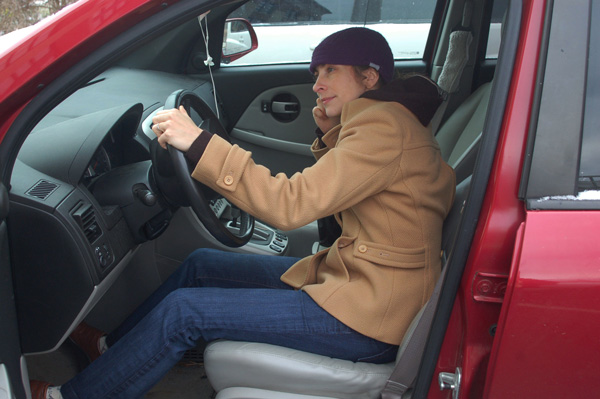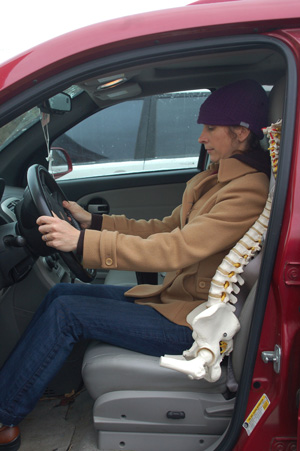Equine veterinarians are professionals who, for the most part, try to take care of themselves because they see the value of preventive medicine. However, equine veterinarians also spend a lot of time in their vehicles, often multi-tasking, and sometimes they fall into bad postural habits.

We asked licensed physical therapy assistant Michelle Friend to give us some tips on how veterinarians can stay healthier with better posture when sitting and driving. Not only does Friend work with two McKenzie spine therapists at Drayer Physical Therapy Institute in Lexington, Kentucky, she is married to an equine practitioner, giving her a unique perspective on this matter.
The good thing about these tips is that by following them, veterinarians can reap rich benefits with very little effort on their part. Fixing your posture is easy and doesn’t take much time, but it might prevent loss of time later when there is an injury from repetitive bad posture.
The first signs of faulty posture may present as difficulty transitioning out of the vehicle, sacroiliac (SI) joint area or low- back stiffness or pain, or a “crampy” feeling in the buttocks or thighs.
First, be honest: How often are you driving or sitting at a stoplight, slouched in the seat or leaning to the side, sometimes while talking on the phone or taking notes?
Tip #1: Buy and use a hands-free kit for your mobile phone.
One veterinarian said, “Stoplights are for email and texting.” They are also good opportunities for a quick posture check!
Friend gave these tips for good vehicle posture:
·The seat back should be erect.
·Don’t recline or lean on the center console.
·Your head should be touching the headrest.
·Your head should be level (don’t let your chin jut out).
·Your ears should be over your shoulders.
·Your shoulders should be over your hips.
·Your spine should be a natural ‘S’ curve (not in a ‘C’ curve; see illustrations).
·Your hips should be at a 90° angle to your trunk.
·Your legs should be level from hip to knee; make sure your hips are not lower than your knees.
·You should be close enough to the pedals that you are not pulling your spine into a ‘C’ curve.
·When your hands are at 10 o’clock and 2 o’clock on the steering wheel, there should be a 15° angle in your elbows.
Tip #2: At stop signs or stop lights, check your posture and correct it.
One of the problems with using correct posture is that not all vehicle seats are made to allow you to sit properly, noted Friend. So it might be necessary to crank up the lumbar support of the vehicle, add a lumbar roll behind your lower back just above your belt, or place a wedge between you and your seat to keep your hips and legs level and prevent your spine from slouching into the unwanted ‘C’ curve.

Friend said that veterinarians should keep in mind that a practice vehicle is an important piece of equipment, and you should consider more than the size and color at purchase.
Tip #3: Having good lumbar support built into the vehicle seat and having a seat that is adjustable to help you sit properly are considerations when shopping for a practice vehicle.
Veterinarians whose focus is on reproduction often spend 18 hours a day in their vehicles during breeding season. Friend said that one of the saving points for these veterinarians is that they are in and out of their vehicles often and aren’t driving for hours without standing up and moving around. She noted that it is easier to keep good posture for 20 minutes than for two hours while driving.
Friend said that women veterinarians have a couple of specific vehicle postural problems. One is that because most women have less upper body muscle, they might be more susceptible to postural or stretch injuries. This might present first in the form of tightness, spasms, headaches or tingling across the cervicothoracic junction or interscapular areas. Therefore good posture is doubly important for female veterinarians.

She also noted that women veterinarians often pull their hair back to keep it out of their faces while working and driving. Unfortunately, that clip or ponytail can cause your head to be pushed forward away from the headrest, causing stress on the neck and shoulders. If the female veterinarian reclines the seat back to move the headrest away from the back of her head, then she has to work harder at maintaining that ideal ‘S’ curve.
Something for both male and female vets to remember is that if your legs are outstretched to reach the pedals and your hamstrings are tight, the pelvis will be reclined, pulling your back into the faulty ‘C’ curve.
Veterinarians need to attend to clients in order to make money. If the veterinarian is painful or sore because of stress caused by improper posture while driving, he or she will experience a change in attitude and a reduction in efficiency. Over time, these stresses can cause real injury to the body, resulting in time away from practice while recuperating a body that can no longer compensate for awkward positioning.








